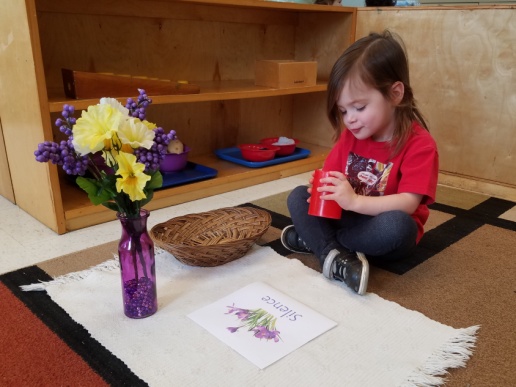From the desk of Renae Bartholomew

Dr. Maria Montessori first created the Silence Game while working with children who were partially deaf. She began by implementing an activity which involved her standing at the back of the room with the children facing away from her while she quietly called the name of each child. The children would listen intently, and when they heard their name called, they would quietly walk to the back of the room and remain silently by her side.
There are now several similar activities implemented in Montessori schools all around the world. Though it may vary from classroom to classroom, The Silence Game is a wonderful activity that can help children relax, create a calm environment, lengthen attention spans, and learn to appreciate silence.

I recently had the opportunity to implement the Silence Game in a Montessori preschool environment. We used Dr. Montessori’s original model for our game. This was our preschool group’s first experience playing it and surprisingly, most had no problem at all remaining still. Some however, couldn’t resist the temptation to fidget, or to make silly faces at the friend beside them. It was interesting to see how each child reacted differently to the Silence Game. Overall, the experience was pleasant and I was quite impressed with specific children doing much better at being silent than I had anticipate. If practiced over time, each child’s attention span should increase, as well as their ability to control their bodies.
Variations on The Montessori Silence Game:
- Darken the room and light a candle while the Silence Game is taking place.
- Ring a bell to signal the starting of the Silence Game and ring a bell to signal the end of the Silence Game.
- Have the group close their eyes and only open them when they hear their name called.
- Give the children a task to focus on during the Silence Game. For example, challenge them to “hear” noises that they may not normally be aware of. Once the silence game had ended, encourage them to share with the group what they “heard”.
- With older children, simply have a sign that has the word, “SILENCE” written on it and when the sign is held up or on display, they will know that it’s time to tuck their sounds away and work silently until they hear a signal that ends silent work time such as a bell or chime.
- Create an opportunity for children to enjoy silence on their own. Place a basket on a shelf in which there would be a mat to sit on as well as a one-minute sand timer. The child simply takes the basket to a spot on the floor and removes the contents. The child should sit on the ‘silence mat’ with their legs crossed and flip over the one-minute timer. The child needs to sit very still and quiet for the duration of the time while focusing on the sounds around them.
